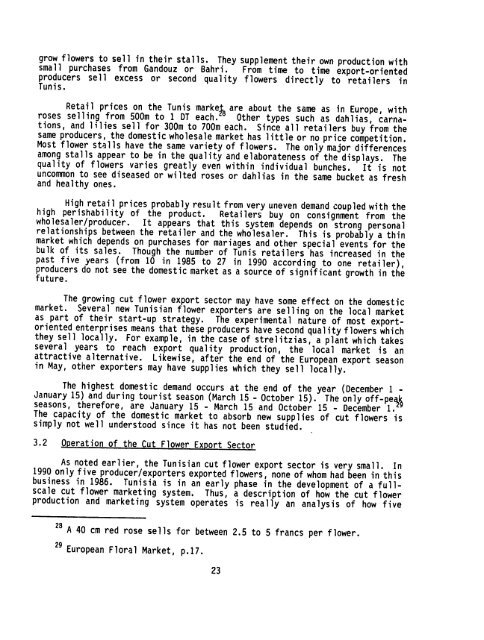APIP Agricultural Policy Implementation Project
APIP Agricultural Policy Implementation Project
APIP Agricultural Policy Implementation Project
You also want an ePaper? Increase the reach of your titles
YUMPU automatically turns print PDFs into web optimized ePapers that Google loves.
grow flowers to sell intheir stalls. They supplement their own production with<br />
small purchases from Gandouz or Bahri. From time to time export-oriented<br />
producers sell excess or second quality flowers directly to retailers in<br />
Tunis.<br />
Retail prices on the Tunis market are about the same as in Europe, with<br />
roses selling from 500m to 1 DT each. J Other types such as dahlias, carnations,<br />
and lilies sell for 300m to 700m each. Since all retailers buy from the<br />
same producers, the domestic wholesale market has little or no price competition.<br />
Most flower stalls have the same variety of flowers. The only major differences<br />
among stalls appear to be in the quality and elaborateness of the displays. The<br />
quality of flowers varies greatly even within individual bunches. It is not<br />
uncommon to see diseased or wilted roses or dahlias in the same bucket as fresh<br />
and healthy ones.<br />
High retail prices probably result from very uneven demand coupled with the<br />
high perishability of the product. Retailers buy on consignment from the<br />
wholesaler/producer. It appears that this system depends on strong personal<br />
relationships between the retailer and the wholesaler. This is probably a thin<br />
market which depends on purchases for mariages and other special events for the<br />
bulk of its sales. Though the number of Tunis retailers has increased in the<br />
past five years (from 10 in 1985 to 27 in 1990 according to one retailer),<br />
producers do not see the domestic market as a source of significant growth inthe<br />
future.<br />
The growing cut flower export sector may have some effect on the domestic<br />
market. Several new Tunisian flower exporters are selling on the local market<br />
as part of their start-up strategy. The experimental nature of most exportoriented<br />
enterprises means that these producers have second quality flowers which<br />
they sell locally. For example, inthe case of strelitzias, a plant which takes<br />
several years to reach export quality production, the local market is an<br />
attractive alternative. Likewise, after the end of the European export season<br />
in May, other exporters may have supplies which they sell locally.<br />
The highest domestic demand occurs at the end of the year (December I -<br />
January 15) and during tourist season (March 15 - October 15). The only off-pe<br />
seasons, therefore, are January 15 - March 15 and October 15 - December I."<br />
The capacity of the domestic market to absorb new supplies of cut flowers is<br />
simply not well understood since it has not been studied.<br />
3.2 Operation of the Cut Flower Export Sector<br />
As noted earlier, the Tunisian cut flower export sector isvery small. In<br />
1990 only five producer/exporters exported flowers, none of whom had been inthis<br />
business in 1986. Tunisia is in an early phase in the development of a fullscale<br />
cut flower marketing system. Thus, a description of how the cut flower<br />
production and marketing system operates is really an analysis of how five<br />
28 A 40 cm red rose sells for between 2.5 to 5 francs per flower.<br />
29 European Floral Market, p.17.<br />
23

















